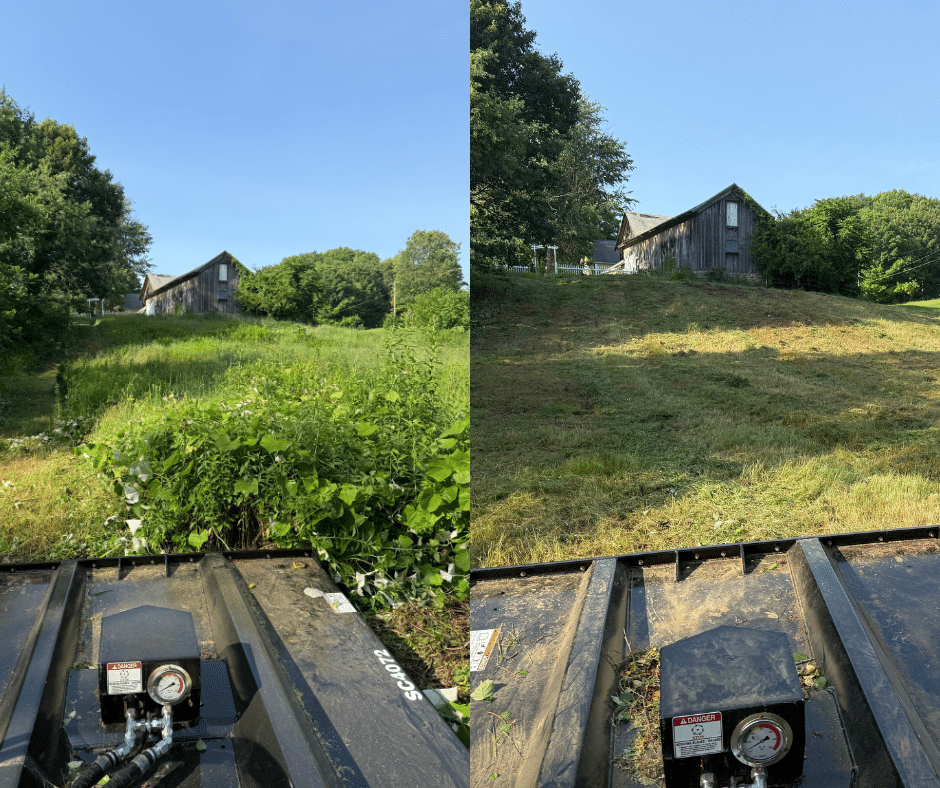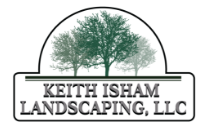What to Know About Brush Hogging in Western MA & Northern CT

Brush Hogging, Bush Hogging, Rotary Cutting: What’s the Difference?
Brush hogging, bush hogging, or rotary cutting — whatever you choose to call it — are interchangable terms for a powerful land management technique that involves clearing out thick undergrowth, tall weeds, overgrown grass, and even small trees using a heavy-duty rotary mower. TIt’s ideal for large, overgrown properties that can’t be cleared with a standard lawnmower or string trimmer.
Brush hogging is most commonly used to maintain: Fields and pastures, trails and access roads, vacant lots, and arge residential or commercial parcels
How It Works
- Attachment to Tractor: A brush hog is hitched to a tractor via a 3-point hitch and powered by the tractor’s PTO (Power Take-Off) shaft.
- Rotary Blades Spin at High Speeds: The PTO powers large, heavy-duty blades inside the mower deck. These blades spin rapidly (but not razor-sharp — they’re designed more for force than precision).
- Cutting Through Thick Vegetation: The spinning blades smash through tall grass, thick brush, weeds, and even saplings up to several inches thick, cutting and mulching them as the machine moves forward.
- Mulching Effect: The chopped material is typically left on the ground behind the mower, helping with erosion control or acting as natural mulch.
- Operator Control: The operator drives in overlapping passes to ensure even clearing and to avoid missing patches flattened by the tires.
Applications
Brush hogging can be an effective land management practice for a variety of commercial and even residential properties. Brush hogging makes sense for you if your property is:
- Larger than one acre
- Overgrown with thick grass, brush, or saplings
- Used for farming, livestock, or recreational activities
- Preparing for development, construction, or landscaping
- Adjacent to wooded areas that require firebreaks or boundary clearing
- Difficult to manage with traditional mowers or landscaping tools
Considerations for Brush Hogging in New England
New England’s seasonal patterns make it especially important to plan your land clearing project carefully. Before scheduling brush hogging services in Western Massachusetts or Northern Connecticut, consider the following regional factors:
- Dry Ground Conditions
Brush hogging should be done when the ground is dry to prevent rutting, soil compaction, and equipment damage. Wet or muddy terrain can lead to uneven cuts and increase the risk of getting stuck.
- Tick and Insect Season
Brushy areas often harbor ticks, mosquitoes, and other pests, especially in spring and summer. Wear appropriate clothing and consider insect repellent when you’re walking the property beforehand.
- Local Wildlife
Be mindful and cautious of nesting birds, deer fawns, or other wildlife that may be concealed in overgrown areas. It’s best to schedule work outside of nesting or birthing seasons when possible.
- Sloped or Uneven Terrain
New England landscapes are known for rocky, hilly ground. Brush hogging equipment needs to be stable and well-handled to prevent tipping or blade damage on uneven surfaces.
How to Get a Clean Cut With Your Rotary Cutter
- Remove any debris from the area.
Take a precautionary walk around the property, scanning for any debris such as rocks, large stumps, or metal scraps that could interfere with your equipment. Obstructions like these can pose serious safety hazards, including dangerous projectiles or fire from sparks. They can also cause serious damage to your blades.
- Slow and steady wins the race
Be sure to move slowly and steadily. Rushing can lead to uneven cutting and unnecessary strain on your equipment, while controlled passes ensure a cleaner finish and improved safety. Slower speeds also give you more time to spot hidden obstacles that may have been missed during your initial walk-through.
- Overlap your passes by 10-20%
This ensures you’re cutting any grass or brush that may have been flattened by your tires on the previous pass. Slightly overlapping into already-cleared areas also gives debris like grass and small branches room to discharge freely, helping prevent clogs and reducing strain on your equipment.
- Adjust Cut Height
Set your brush hog to the right height, usually 2 to 8 inches above the ground. Taller settings are better for rough terrain or thicker brush, while lower settings give a cleaner finish on smoother land.
- Sharpen Your Blades
Dull blades can tear vegetation instead of cutting it cleanly, leading to an uneven finish and putting extra strain on your equipment. Avoid these issues by sharpening your blades every 8 to 10 hours of use with an angle grinder or bench grinder. Maintaining sharp blades not only improves cutting quality but also protects the longevity of your machinery.
Professional Brush Hogging Services in Western MA & Northern CT
At Keith Isham Landscaping, we specialize in brush hogging and rotary cutting services for residential and commercial properties across Western MA & Northern CT. Count on us for efficient and x service that will restore the condition of your outdoor space. Known for our exceptional customer service and quick turnaround times, we can take your project from start to beautiful finish.
Interested in our land clearing services? Please fill out our contact form or call Keith at (413) 531-1216.
